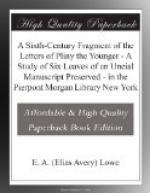[Footnote 1: r added above
the line by the scribe or by a
contemporary hand.]
[Footnote 2: i added above
the second u by the scribe or by a
contemporary hand.]
[Footnote 3: The scribe wrote dissitientis.
A contemporary hand
changed the second i to e
and wrote an n above the t.]
[Footnote 4: de is cancelled
by means of dots above the d and
e and oblique strokes drawn through
them.]
[Footnote 5: The strokes over the
i at the end of this word and at
the beginning of the next were added by
a corrector who can not be
much older than the thirteenth century.]
PART II.
THE TEXT OF THE MORGAN FRAGMENT
by
E. K. RAND
THE MORGAN FRAGMENT AND ALDUS’S
ANCIENT CODEX PARISINUS.[1]
[Sidenote: The Codex Parisinus]
Aldus Manutius, in the preface to his edition of Pliny’s Letters, printed at Venice in 1508, expresses his gratitude to Aloisio Mocenigo, Venetian ambassador in Paris, for bringing to Italy an exceptionally fine manuscript of the Letters; the book had been found not long before at or near Paris by the architect Fra Giocondo of Verona. The editio princeps, 1471, was based on a family of manuscripts that omitted Book VIII, called Book IX Book VIII, and did not contain Book X, the correspondence between Pliny and Trajan. Subsequent editions had only in part made good these deficiencies. More than a half of Book X, containing the letters numbered 41-121 in editions of our day, was published by Avantius in 1502 from a copy of the Paris manuscript made by Petrus Leander.[2] Aldus himself, two years before printing his edition, had received from Fra Giocondo a copy of the entire manuscript, with six other volumes, some of them printed editions which Giocondo had collated with manuscripts. Aldus, addressing Mocenigo, thus describes his acquisition:
“Deinde Iucundo Veronensi Viro singulari ingenio, ac bonarum literarum studiosissimo, quod et easdem Secundi epistolas ab eo ipso exemplari a se descriptas in Gallia diligenter ut facit omnia, et sex alia uolumina epistolarum partim manu scripta, partim impressa quidem, sed cum antiquis collata exemplaribus, ad me ipse sua sponte, quae ipsius est ergo studiosos omneis beneuolentia, adportauerit, idque biennio ante, quam tu ipsum mihi exemplar publicandum tradidisses.”
[Footnote 1: I would acknowledge most gratefully the help given me in the preparation of this part of our discussion by Professor E.T. Merrill, of the University of Chicago. Professor Merrill, whose edition of the Letters of Pliny has long been in the hands of Teubner, placed at my disposal his proof-sheets for the part covered in the Morgan fragment, his preliminary apparatus




